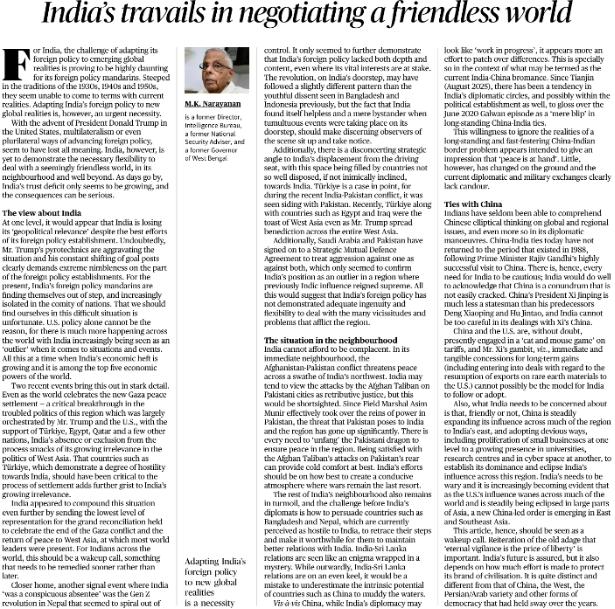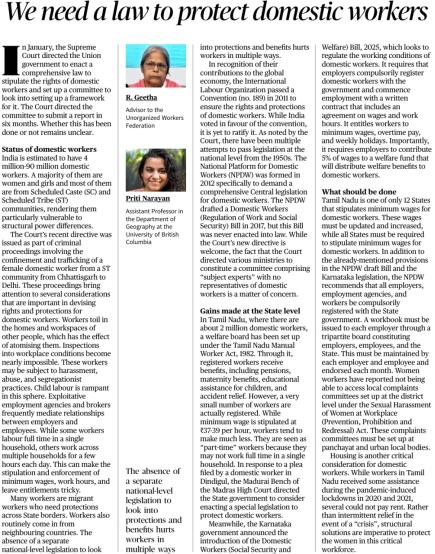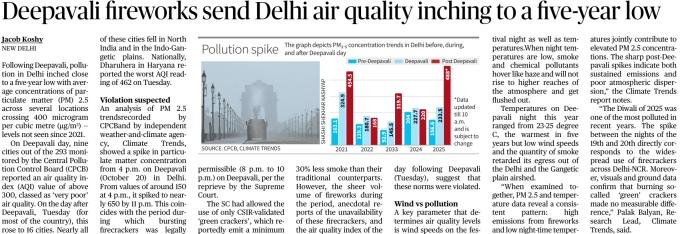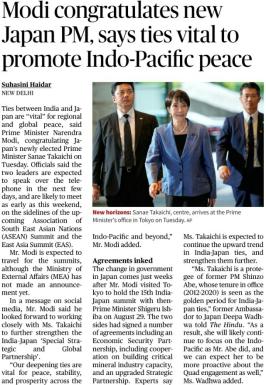Daily Current Affairs for UPSC 22nd Oct 2025



| Index |
| S.No | Topic | Page No |
| Daily Hindu Analysis (YouTube) |
| 1. | India’s travails in negotiating a friendless world |
|
| 2. | We need a law to protect domestic workers |
|
| 3. | Net FDI inflow fell by 159% in August: RBI’s data reveals |
|
| 4. | Deepavali fireworks send Delhi air quality inching to a five-year low |
|
| 5. | India’s Kabul mission is upgraded to embassy |
|
| 6. | Modi congratulates new Japan PM, says ties vital to promote Indo-Pacific peace |
|
| Daily Current Affairs (App) |
| 7. | Graded Response Action Plan (GRAP) |
|
| 8. | Sanae Takaichi Becomes Japan’s First Female Prime Minister |
|
| 9. | FSSAI Bans Use of ‘ORS’ on Food Labels and Advertisements |
|
| 10. | India’s Passport Rank Drops to 85th in 2025 Henley Passport Index |
|
India’s travails in negotiating a friendless world  Context
Context
The article, written by M.K. Narayanan (former National Security Adviser and ex-Governor of West Bengal), critically examines the challenges faced by India’s foreign policy in adapting to a rapidly evolving global and regional order. It argues that India’s diplomatic approach—rooted in traditional non-alignment and moral posturing—needs a major recalibration to address the complexities of a “friendless world” dominated by transactional geopolitics, assertive neighbours, and weakening multilateralism.
What is it all about?
India, despite being one of the world’s top five economies, is finding itself increasingly isolated or sidelined in key international developments. The decline of multilateralism (especially after the Trump era) and the rise of hard-nosed, interest-driven foreign policies across the world have left India struggling to balance moral postures with strategic pragmatism. The article argues that India’s foreign policy establishment is steeped in outdated traditions of the 20th century—emphasizing autonomy and moralism—when what is required today is nimbleness, flexibility, and pragmatic alignment.
Detailed Analysis
1. The Changing Global Context
- Post-Trump era disorder: The United States under Donald Trump eroded faith in multilateral institutions and cooperative global governance.
- Rise of transactional diplomacy: Nations now prioritize national interest over ideology or values.
- India’s challenge: As global power centres realign, India has not demonstrated sufficient agility in adapting to new realities.
“Adapting India’s foreign policy to new global realities is an urgent necessity.”
2. Decline in India’s Geopolitical Influence
- Despite economic rise and global stature, India is increasingly perceived as an outlier in key international decisions.
- India’s foreign policy is often reactive rather than proactive, lacking clear strategic direction.
- The constant shifting of global power posts—from the U.S. to China, from West Asia to Indo-Pacific—requires agility that India’s bureaucracy-driven diplomacy often lacks.
3. Regional Setbacks: The Neighbourhood First Dilemma a. Afghanistan–Pakistan Axis - The Taliban’s consolidation and Pakistan’s influence in Kabul have diminished India’s regional leverage.
- India’s cautious approach post-2021, unlike its proactive engagement in the past, has made it appear as a bystander in key security developments.
b. China’s Expanding Influence - Post-Galwan (2020), India–China relations have stagnated.
- Despite border tensions, China’s trade with India continues to rise, while its political and strategic influence deepens across South Asia and West Asia.
- China’s renewed global activism under Xi Jinping—infrastructure, technology, and diplomacy—has left India struggling to match scale and influence.
c. Shifting West Asian Dynamics - Turkey, Saudi Arabia, and Pakistan have forged new strategic alignments, such as the Strategic Defence Agreement, often excluding India.
- India’s earlier goodwill in West Asia has waned as new power brokers (Turkey, China) fill the vacuum.
4. The Indo-Pacific and Strategic Restraint - India’s Indo-Pacific policy, though well-articulated, is hampered by limited military and economic projection compared to the U.S. and Japan.
- The Quad’s strategic potential is underutilized, with India adopting a cautious posture vis-à-vis China.
5. The Structural Weaknesses in India’s Foreign Policy - Lack of coherent long-term doctrine: India’s foreign policy remains an extension of ad hoc decisions rather than a unified grand strategy.
- Over-reliance on moral diplomacy: India continues to emphasize values like sovereignty, democracy, and peace—important, but often without adequate material backing.
- Diplomatic overstretch: India’s ambitions as a global power are not always matched by its institutional capacity or financial muscle.
6. The Way Forward - Recalibrate strategy: India must blend idealism with realism—pursuing value-based diplomacy while safeguarding hard interests.
- Reassert leadership in neighbourhood: Revitalize South Asia through economic incentives, connectivity, and people-centric diplomacy.
- Leverage multilateral forums: Use platforms like G20, SCO, BRICS, QUAD to project India’s leadership on global governance, AI, and climate change.
- Strategic partnerships: Deepen ties with middle powers like Japan, France, and Indonesia to counterbalance China’s rise.
- Rebuild credibility: India’s credibility as a reliable partner—especially in trade, defence, and technology—needs stronger institutional delivery.
Key Takeaway India’s current predicament stems not from lack of potential, but from diplomatic inertia. In a rapidly polarising world, adaptability, clarity of priorities, and credible partnerships are essential for India to reclaim strategic space and prevent marginalisation.
UPSC Mains Q. “India’s foreign policy appears to be struggling to find balance between moral idealism and strategic pragmatism in a changing world order.” Critically examine.
We need a law to protect domestic workers

Syllabus Mapping
- GS Paper 2:
- Welfare Schemes for Vulnerable Sections of the Population.
- Mechanisms, Laws, and Institutions for the Protection of Vulnerable Groups.
- Issues Relating to Poverty and Employment.
- GS Paper 3:
- Inclusive Growth and Labour Reforms.
- Informal Sector and Employment Generation.
Context In January 2025, the Supreme Court of India directed the Union Government to enact a comprehensive national law protecting the rights of domestic workers and to set up a committee to draft a legal framework. However, the status of this directive remains unclear. The issue highlights a long-standing policy gap — while India depends heavily on domestic workers for household and care work, there is no uniform national legislation to regulate their employment, wages, or working conditions.
What is it all about?
- India is estimated to have 4–9 million domestic workers, most of whom are women, often from Scheduled Castes (SC) and Scheduled Tribes (ST), making them highly vulnerable to exploitation, trafficking, and harassment.
- Many of them lack written contracts, social security, fair wages, and protection under existing labour laws.
- Despite multiple efforts — from the National Policy for Domestic Workers (1950s) to the Domestic Workers (Regulation of Work and Social Security) Bill, 2017 — a national law ensuring rights and protections has not yet been enacted.
Detailed Analysis 1. Judicial Intervention and the Supreme Court Directive
- The Supreme Court’s recent order emphasized the urgent need for legislative protection and directed the government to establish a committee of “subject experts” to draft a legal framework.
- The Court’s intervention came in light of criminal cases of confinement and trafficking, which highlighted systemic abuse and lack of legal recourse for domestic workers.
2. Status and Challenges of Domestic Workers a. Socio-economic profile - 90% of domestic workers are women, mostly from marginalized communities (SC/ST, minorities, migrants).
- Many are employed in multiple households, without contracts or job stability, and are excluded from social security schemes.
b. Nature of employment - The private household setting makes labour inspections nearly impossible.
- Exploitative practices like underpayment, long hours, sexual harassment, and wage theft are rampant.
- Most are unregistered, making it difficult to ensure minimum wage or benefits.
c. Legal invisibility - Domestic workers are excluded from most national labour laws such as:
- Industrial Disputes Act, 1947
- Minimum Wages Act, 1948 (applies only in some states)
- Employees’ State Insurance Act, 1948
- Payment of Wages Act, 1936
3. Existing State-Level Initiatives Tamil Nadu - The Tamil Nadu Manual Workers Act, 1982 includes domestic workers under its welfare board.
- Registered workers receive pensions, maternity benefits, education aid, and accident relief.
- However, only a small proportion of workers are registered, and many continue to earn below-statutory wages (₹37–39/hr).
Karnataka - Announced plans to enact a specific Domestic Workers’ Welfare Bill (2025) to regulate wages, working hours, and contracts.
- The Bill mandates written contracts, minimum wage, overtime pay, and a 5% welfare fund contribution by employers.
4. International Framework - The ILO Convention No. 189 (2011) recognizes domestic work as “work” and ensures rights to decent employment, social protection, and fair wages.
- India voted in favour but has not yet ratified it — a major gap in aligning domestic law with global labour standards.
- Countries like Philippines and South Africa have enacted specific domestic worker protection laws, serving as models.
5. The Way Forward a. Enact a Comprehensive National Law - Define domestic work clearly.
- Mandate registration of employers and workers.
- Ensure minimum wages, social security, and grievance redressal mechanisms.
b. Welfare and Social Security - Establish a National Domestic Workers’ Welfare Fund with contributions from the government and employers.
- Ensure access to maternity benefits, health insurance, pensions, and accident relief.
c. Empowerment and Recognition - Recognize domestic workers as part of the formal labour force contributing to the economy.
- Facilitate formation of domestic worker unions and cooperatives for collective bargaining.
d. Ratify ILO Convention 189 - Align national legislation with international labour standards to ensure dignity and equality for domestic workers.
Significance Protecting domestic workers aligns with: - Article 14 & 21 – Equality before law and right to life with dignity.
- Article 23 – Prohibition of forced labour.
- Directive Principles (Articles 39 & 43) – Right to adequate livelihood and humane working conditions.
- SDG 8 (Decent Work and Economic Growth) – Promoting inclusive and productive employment.
UPSC Mains Q.
Despite their crucial contribution to the economy, domestic workers remain among the most unprotected sections of India’s workforce. Discuss the need for a comprehensive national law to ensure their rights and welfare
Net FDI inflow fell by 159% in August: RBI’s data reveals

Syllabus Mapping: - GS-III (Indian Economy): External sector, BoP, capital flows.
Context RBI data show that net Foreign Direct Investment (FDI) into India was negative in August 2025—more money left the country than came in. Net outflow stood at –$616 million, a 159% decline y-o-y. This is the second month in FY 2025-26 when outflows exceeded inflows.
What is FDI?
- FDI: long-term investment by a non-resident entity in an Indian enterprise with management influence (equity + reinvested earnings + intra-company loans).
- Net FDI = Gross FDI inflows – (repatriation/disinvestment by foreign firms + overseas direct investment by Indian companies).
What the latest numbers say - Gross inflows in Aug 2025: $6.05 bn (lowest this FY; –30.6% y-o-y, –45.5% m-o-m).
- Money leaving in Aug 2025:
- Repatriation/disinvestment by foreign firms: $4.93 bn (–5.4% y-o-y; ~+30% over July).
- Overseas direct investment by Indian firms: $1.74 bn (–29.7% y-o-y; lowest in a year).
- Result: outflows > inflows ⇒ net FDI turned negative (–$0.62 bn).
The bigger picture (April–August 2025) - Net FDI: $10.13 bn, >12% higher than the same period last year.
- Drivers: +18.2% rise in gross inflows ($43.76 bn) and –6.1% fall in repatriation/disinvestment ($21.21 bn).
- Overseas investment by Indian companies also fell ~26% in this five-month period.
Why it matters - A negative month reflects weak deal closures/reinvestments and higher profit repatriation, pressuring the BoP and rupee in the short run.
- The April–August improvement suggests underlying resilience, but sustaining inflows will need policy clarity, faster approvals, and stable macro conditions.
UPSC Prelims With reference to Foreign Direct Investment (FDI) statistics released by the RBI, consider the following: 1. Net FDI is calculated by subtracting repatriation/disinvestment by foreign investors and overseas direct investment by Indian companies from gross FDI inflows. 2. Portfolio investments (FPI/FII) are included in FDI inflows. 3. Reinvested earnings of foreign companies operating in India are a part of FDI. Which of the statements is/are correct? a) 1 and 3 only
b) 2 only
c) 1 and 2 only
d) 1, 2 and 3
Answer: a) 1 and 3 only
Deepavali fireworks send Delhi air quality inching to a five-year low

Syllabus Mapping:
- GS Paper 3 (Environment): Pollution and mitigation strategies, environmental policies and acts.
Context · Following Deepavali 2025, air pollution levels in Delhi surged sharply, reaching the worst levels since 2021. · Data from the Central Pollution Control Board (CPCB) showed average concentrations of Particulate Matter (PM 2.5) exceeding 400 µg/m³, pushing the city’s Air Quality Index (AQI) into the ‘Severe’ category (above 400). · Nearly nine out of 293 CPCB-monitored cities across India recorded AQI above 300, reflecting widespread pollution across North India and the Indo-Gangetic Plains.
Key Terms
1. PM 2.5
- Definition: Fine particulate matter with diameter ≤2.5 micrometres, small enough to enter the bloodstream.
- Sources: Combustion (vehicles, biomass burning, fireworks, industrial emissions).
- Health Impacts: Causes cardiovascular and respiratory diseases, and premature deaths.
2. AQI (Air Quality Index) - Definition: A composite index used to measure and communicate air quality status.
- Categories:
- Good (0–50)
- Satisfactory (51–100)
- Moderate (101–200)
- Poor (201–300)
- Very Poor (301–400)
- Severe (401–500)
3. CPCB - The Central Pollution Control Board (CPCB), statutory organisation, was constituted in September, 1974 under the Water (Prevention and Control of Pollution) Act, 1974. Further, CPCB was entrusted with the powers and functions under the Air (Prevention and Control of Pollution) Act, 1981.
- Monitors air, water, and noise pollution and implements National Air Quality Monitoring Programme (NAMP).
Detailed Analysis 1. Data Highlights
- PM 2.5 levels spiked from ~150 µg/m³ at 4 p.m. to nearly 650 µg/m³ by 11 p.m. on Deepavali night (October 20).
- Post-Deepavali AQI touched 488, compared to 233 the previous day.
- The worst AQI was reported in Dharuhera, Haryana (462).
2. Factors Contributing to Pollution Spike a. Firecracker Emissions
- Despite the Supreme Court’s limited window (8–10 p.m.) for bursting only CSIR-validated “green crackers”, norms were widely violated.
- “Green crackers” emit ~30% less smoke, but their large-scale use still significantly raised PM levels.
b. Weather Conditions - Low wind speeds prevented pollutant dispersion.
- Higher night temperatures (23–25°C) trapped smoke near the surface, creating a temperature inversion — a key reason pollutants couldn’t escape into the upper atmosphere.
- The Indo-Gangetic Plains’ stagnant air further worsened accumulation.
3. Wider Implications - Indicates both sustained emissions and poor atmospheric dispersion.
- Demonstrates the limited effectiveness of the “green cracker” initiative without strict enforcement.
- Reinforces the need for comprehensive air quality management, not just seasonal interventions.
UPSC Prelims Q. With reference to air pollution in India, consider the following statements: 1. PM 2.5 refers to suspended particles smaller than 2.5 micrometres, capable of penetrating deep into human lungs. 2. The Central Pollution Control Board (CPCB) operates under the Ministry of Environment, Forest and Climate Change. 3. The Graded Response Action Plan (GRAP) is implemented only in Delhi. Which of the statements given above is/are correct?
a) 1 and 2 only
b) 2 and 3 only
c) 1 and 3 only
d) 1, 2 and 3
Answer: a) 1 and 2 only
India’s Kabul mission is upgraded to embassy

Syllabus Mapping
- GS-II: International Relations – India’s neighbourhood policy; India–Afghanistan relations; recognition vs engagement; Vienna Convention on Diplomatic Relations.
Context Days after the visit of the Taliban administration’s Acting Foreign Minister Amir Khan Muttaqi to New Delhi, India has upgraded its Technical Mission in Kabul to the Embassy of India in Afghanistan, with immediate effect. Until an Ambassador is appointed, a Chargé d’Affaires (CDA) will head the mission.
What is this move about?
- Background: India shut its Kabul Embassy in Aug 2021 after the Taliban takeover, citing security concerns. A Technical Mission was later deployed mainly to oversee humanitarian aid and limited development work.
- Now: The Mission’s status has been restored to a full Embassy, signalling an elevation of political engagement and capacity to deliver consular and development functions on the ground.
What the move does and does not imply - Does:
- Enhances consular services (visas, assistance to Indian nationals, Afghan students/patients).
- Improves oversight of humanitarian aid & legacy development projects (health, education, irrigation, power).
- Provides a platform for direct security dialogue (counter-terrorism, safe travel for Indians, monitoring threats from IS-K, Al Qaeda affiliates, anti-India groups).
- Facilitates economic & connectivity outreach (trade, pharmaceuticals, wheat aid; long-term links to Chabahar and regional corridors).
- Does not automatically mean formal recognition of the Taliban government. It reflects de facto engagement, not necessarily de jure recognition (which a few powers debate; the article notes Russia has recognised the Taliban as de jure—India has not).
Strategic/Foreign-Policy Significance 1. Bilateral reset with caution: India keeps channels open while reiterating red lines—Afghan soil not to be used for terrorism, an inclusive polity, and protection of women’s and minorities’ rights.
2. Regional calculus: With Iran, China, Russia, Gulf and Central Asian states engaging Kabul, India avoids strategic marginalisation in Afghanistan’s political economy.
3. Security externality: Tensions on the Durand Line and terror spillovers elevate the need for situational awareness and rapid consular response. 4. People-centric diplomacy: Restored embassy can scale scholarships, medical visas, educational partnerships—traditional strengths of India’s Afghan outreach.
5. Diplomatic signalling: A CDA heading the mission provides flexibility—full ambassadorial appointment can be timed with further security and political assurances.
Risks & Mitigation
- Security risks to personnel and premises → phased staffing, enhanced protection, close coordination with local authorities and friendly missions.
- Perception of recognition → maintain clarity that this is about functional presence and humanitarian delivery, not unconditional endorsement.
- Human-rights concerns → leverage access to press for women’s education/work rights and inclusive governance, aligning with UN benchmarks.
UPSC PrelimsQ. With reference to Indian diplomatic missions, consider the following statements:
1. A Chargé d’Affaires (CDA) heads an embassy in the absence of an Ambassador.
2. Upgrading a technical mission to an embassy automatically amounts to de jure recognition of the host government.
3. Functions of an embassy under the Vienna Convention on Diplomatic Relations (1961) include protecting the interests of the sending state, negotiating with the host government, and promoting friendly relations. Which of the statements given above is/are correct?
a) 1 and 3 only
b) 2 only
c) 1 and 2 only
d) 1, 2 and 3
Answer: a) 1 and 3 only.
Modi congratulates new Japan PM, says ties vital to promote Indo-Pacific peace

Syllabus Mapping
- GS Paper 2: India and its neighbourhood relations; Bilateral, regional and global groupings; India’s role in Indo-Pacific.
Context Prime Minister Narendra Modi congratulated Japan’s newly elected Prime Minister Sanae Takaichi, highlighting that India–Japan ties are vital for regional and global peace, particularly in the Indo-Pacific region. The statement came amid plans for a potential bilateral meeting on the sidelines of the upcoming ASEAN Summit and the East Asia Summit (EAS). This change in Japan’s leadership follows a period of strong strategic engagement between the two nations under the 15th India–Japan Summit (August 2025) held between PM Modi and then PM Shigeru Ishiba.
What is it all about? The upgrading of India–Japan ties underlines the countries’ shared vision for a Free, Open, and Inclusive Indo-Pacific (FOIP). PM Modi expressed optimism that cooperation under PM Sanae Takaichi, a protégé of former PM Shinzo Abe, would deepen the Special Strategic and Global Partnership—a status accorded in 2014. This partnership is grounded in:
- Security and Defence Cooperation
- Economic Resilience and Technology Partnership
- Infrastructure and Connectivity Projects
- Coordination in Multilateral Forums like QUAD, ASEAN, and EAS
Detailed Analysis 1. Strategic and Diplomatic Dimensions - India and Japan share a Special Strategic and Global Partnership (SSGP) aimed at regional stability and maritime security.
- Both nations are members of the Quadrilateral Security Dialogue (QUAD), along with the U.S. and Australia, focusing on freedom of navigation, supply-chain resilience, and countering coercive practices in the Indo-Pacific.
- Japan’s new leadership under Takaichi is expected to maintain continuity in these policies, as she is ideologically aligned with the late Shinzo Abe, who initiated Japan’s Indo-Pacific strategy.
2. Economic and Technological Cooperation At the 15th India–Japan Summit (Aug 2025): - The two sides signed agreements on:
- Economic Security Partnership, focusing on critical minerals and supply chain diversification.
- Digital partnership and semiconductor manufacturing.
- Upgraded Strategic Partnership promoting cooperation in cyber and emerging technologies.
- Japan is a key partner in India’s infrastructure push, including:
- Mumbai–Ahmedabad High-Speed Rail Project
- Dedicated Freight Corridors
- Smart City and Clean Energy Projects
3. Indo-Pacific and Regional Peace - The Indo-Pacific region has emerged as a geopolitical theatre of competition, especially amid China’s assertive maritime policies.
- India and Japan coordinate policies to ensure:
- Freedom of navigation and adherence to UNCLOS (United Nations Convention on the Law of the Sea).
- Economic inclusivity through initiatives like the Supply Chain Resilience Initiative (SCRI) with Australia.
- Cooperation in regional groupings such as ASEAN and EAS to balance Chinese influence.
4. Political Symbolism - PM Takaichi’s election symbolizes political continuity for India–Japan relations.
- Her foreign policy outlook is expected to emphasize strategic autonomy while reinforcing cooperation with India, particularly under frameworks like QUAD and ASEAN-led mechanisms.
Significance for India - Strengthens maritime security cooperation and ensures India’s active role in Indo-Pacific governance.
- Deepens economic and technological partnerships, especially in clean energy, digital innovation, and critical minerals.
- Enhances diplomatic leverage within QUAD and regional forums.
- Reinforces trust-based collaboration rooted in shared democratic values and mutual strategic concerns.
UPSC Prelims Q. With reference to India–Japan relations, consider the following statements: 1. India and Japan have a
Special Strategic and Global Partnership based on mutual cooperation in defence, economy, and technology. 2. Japan is a member of both ASEAN and QUAD. 3. The Supply Chain Resilience Initiative (SCRI) is a trilateral framework involving India, Japan, and Australia. Which of the above statements is/are correct? a) 1 and 2 only
b) 2 and 3 only
c) 1 and 3 only
d) 1, 2, and 3
Answer: c) 1 and 3 only
Graded Response Action Plan (GRAP)
Syllabus: GS Paper II – Polity and Governance
Context:
The Graded Response Action Plan (GRAP) is activated when air quality in Delhi-NCR reaches hazardous levels. As the air quality index (AQI) crossed 300, Delhi enforced Stage II of GRAP, prompting the Chief Minister to encourage the use of green crackers during Deepavali to mitigate pollution.
Key Points:
- GRAP is a set of emergency measures to prevent further deterioration of air quality in Delhi-NCR once AQI crosses a certain threshold.
- Approved by the Supreme Court in 2016 under the case M.C. Mehta vs. Union of India, and notified in 2017.
- The Commission for Air Quality Management (CAQM) is responsible for implementing GRAP in the NCR and surrounding regions.
- IITM and IMD provide air quality and meteorological forecasts to guide GRAP implementation.
- EPCA (Environment Pollution Control Authority) used to oversee GRAP till 2020, after which the CAQM took over.
- Stage-wise actions under GRAP based on AQI levels:
- Stage I (Poor AQI: 201-300): Enforce orders on over-aged vehicles.
- Stage II (Very Poor AQI: 301-400): Targeted actions at pollution hotspots; regulated operations of diesel generators.
- Stage III (Severe AQI: 401-450): Restrictions on BS III petrol and BS IV diesel vehicles, and possible school class suspensions for young children.
- Stage IV (Severe Plus AQI >450): Vehicles, except for electric, CNG, or BS-VI diesel and essential goods vehicles, will be barred from entering Delhi.
Source:
The Hindu
Sanae Takaichi Becomes Japan’s First Female Prime Minister
Syllabus: GS Paper II – Governance, Constitution, Polity, Social Justice and International relations
Context: The election of Sanae Takaichi as Japan’s first female Prime Minister represents a landmark event in Japanese politics. This milestone highlights the evolving landscape of gender equality in leadership and the challenges ahead for Japan’s economic and social future.
Key Points: - Sanae Takaichi has made history as Japan’s first female Prime Minister, signaling a shift toward greater gender inclusivity in leadership roles.
- Her election marks a significant milestone in Japan’s political history, a country traditionally dominated by male leaders.
- Takaichi's tenure is expected to focus on addressing Japan’s economic challenges, particularly in the context of an aging population and low growth rates.
- Japan’s political system is a parliamentary government under a constitutional monarchy with the emperor serving as the ceremonial head of state.
- The country is an island nation in East Asia, located in the Northwestern Pacific Ocean.
- Japan’s geographical structure consists of a chain of islands, stretching approximately 1,500 miles from northeast to southwest.
- Major islands of Japan: Hokkaido, Honshu, Shikoku, and Kyushu.
- Japan is bordered by several seas, including the Pacific Ocean (east), Sea of Okhotsk (north), Sea of Japan (west), and East China Sea (southwest).
- As an island nation, Japan has no land borders, which influences its foreign relations and defense strategies.
- Source: The Hindu
FSSAI Bans Use of ‘ORS’ on Food Labels and Advertisements
Syllabus: GS Paper II – Governance, Constitution, Polity, Social Justice and International Relations
Context: The Food Safety and Standards Authority of India (FSSAI) has prohibited the use of the term "ORS" (Oral Rehydration Solution) on food labels and advertisements. This directive is a response to concerns that such usage misleads consumers and violates the Food Safety and Standards Act, 2006.
Key Points:
- FSSAI has banned the term ‘ORS’ on food labels and advertisements, deeming it misleading to consumers.
- The ban follows a review that concluded the term violates the Food Safety and Standards Act, 2006.
- Food business operators are instructed to comply immediately, removing ‘ORS’ from all relevant products and advertisements.
- Previous permissions from July 2022 and February 2024 that allowed the term with a disclaimer have been withdrawn.
- The use of ‘ORS’ without proper context is now classified as misbranding, punishable under the FSSAI Act, 2006.
- FSSAI, under the Ministry of Health and Family Welfare, regulates food safety, ensuring safe and healthy food for the public.
Source: Indian Express
India’s Passport Rank Drops to 85th in 2025 Henley Passport Index
Syllabus: GS Paper II – Governance, Constitution, Polity, Social Justice and International Relations
Context: The
2025 Henley Passport Index reveals a decline in India’s passport ranking, dropping to
85th globally. This index ranks passports by their
visa-free access to destinations, showcasing India’s current position in global travel mobility and comparing it with other countries, especially within South Asia.
Key Points: - India's passport dropped to 85th rank, granting visa-free access to 57 countries, down from 59 in 2024.
- The Henley Passport Index ranks 199 passports worldwide based on visa-free travel access.
- Singapore continues to top the index, with visa-free access to 193 countries, reflecting Asia’s increasing influence in global mobility.
- India’s visa-free countries include Bhutan, Indonesia, Mauritius, Nepal, and Trinidad and Tobago.
- In addition to visa-free travel, Indian passport holders can access visas on arrival in 27 countries like Sri Lanka, Maldives, Jordan, and Qatar.
- India’s passport ranking has fluctuated over time, reaching its peak at 71st in 2006 and dipping to 90th in 2021.
- In comparison to South Asian neighbours, India’s passport rank is moderate:
- Pakistan: 103rd with access to 31 countries.
- Bangladesh: 100th with access to 38 countries.
- Nepal: 101st with access to 36 countries.
- Bhutan: 92nd with access to 50 countries.
Source:
The Hindu



 Context
Context 



